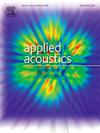Portable in-situ multi-frequency sound calibrator with wide-band balanced armature driver and distortion suppression technology
IF 3.4
2区 物理与天体物理
Q1 ACOUSTICS
引用次数: 0
Abstract
With the increase of noise sources in industrial and living environments, the installation and application demand for outdoor sound level meters and other noise measurement instruments is constantly increasing. In order to facilitate the calibration of sound level meters, it is necessary to carry out research on portable in-situ multi-frequency sound calibrators. In this paper, wide-band balanced armature driver is adopted to replace the high and low frequency moving coil transducers that used in traditional multi-frequency sound calibrators, which would simplify the structure of coupler and driving circuit and improve the working stability of the multi-frequency sound calibrator. Based on the selected wide-band balanced armature driver, the optimization design of the coupler is carried out. Combined with the reference microphone, a multi-frequency sound calibrator integrated circuit system composed of a signal generator, a data acquisition unit, a central processing unit and a human–computer interaction interface is constructed. Experiments show that the total harmonic distortion (THD) of the sound waves at 94 dB-114 dB, 20 Hz-16 kHz meets the requirements of IEC 60942–2017 standard. Whereas the THD is significant at low frequency of 20 Hz-100 Hz, 84 dB. To improve this problem, this study introduced the harmonic notch method and PID algorithm to achieve THD of sound waves in the coupler of less than 2 %. The measurement results of THD were verified by an acoustic analyzer, which proved the effectiveness of the proposed distortion suppression technology. This technology can be widely applied to distortion suppression in other sound calibrators.
采用宽带平衡电枢驱动和失真抑制技术的便携式原位多频校声仪
随着工业和生活环境中噪声源的增加,对室外声级计等噪声测量仪器的安装和应用需求不断增加。为了便于声级计的标定,有必要开展便携式原位多频声校准器的研究。本文采用宽带平衡电枢驱动器取代传统多频声校准器中使用的高、低频动圈换能器,简化了耦合器和驱动电路的结构,提高了多频声校准器的工作稳定性。在选取宽频带平衡电枢驱动器的基础上,对耦合器进行了优化设计。结合参考传声器,构建了由信号发生器、数据采集单元、中央处理器和人机交互接口组成的多频声校准器集成电路系统。实验表明,94 dB ~ 114 dB、20 hz ~ 16 kHz的声波总谐波失真(THD)满足IEC 60942-2017标准的要求。而在20hz - 100hz, 84 dB的低频,THD是显著的。为了改善这一问题,本研究引入谐波陷波法和PID算法,实现了声波在耦合器中的THD小于2%。用声学分析仪对THD的测量结果进行了验证,验证了所提出的失真抑制技术的有效性。该技术可广泛应用于其它声音校准器的失真抑制。
本文章由计算机程序翻译,如有差异,请以英文原文为准。
求助全文
约1分钟内获得全文
求助全文
来源期刊

Applied Acoustics
物理-声学
CiteScore
7.40
自引率
11.80%
发文量
618
审稿时长
7.5 months
期刊介绍:
Since its launch in 1968, Applied Acoustics has been publishing high quality research papers providing state-of-the-art coverage of research findings for engineers and scientists involved in applications of acoustics in the widest sense.
Applied Acoustics looks not only at recent developments in the understanding of acoustics but also at ways of exploiting that understanding. The Journal aims to encourage the exchange of practical experience through publication and in so doing creates a fund of technological information that can be used for solving related problems. The presentation of information in graphical or tabular form is especially encouraged. If a report of a mathematical development is a necessary part of a paper it is important to ensure that it is there only as an integral part of a practical solution to a problem and is supported by data. Applied Acoustics encourages the exchange of practical experience in the following ways: • Complete Papers • Short Technical Notes • Review Articles; and thereby provides a wealth of technological information that can be used to solve related problems.
Manuscripts that address all fields of applications of acoustics ranging from medicine and NDT to the environment and buildings are welcome.
 求助内容:
求助内容: 应助结果提醒方式:
应助结果提醒方式:


